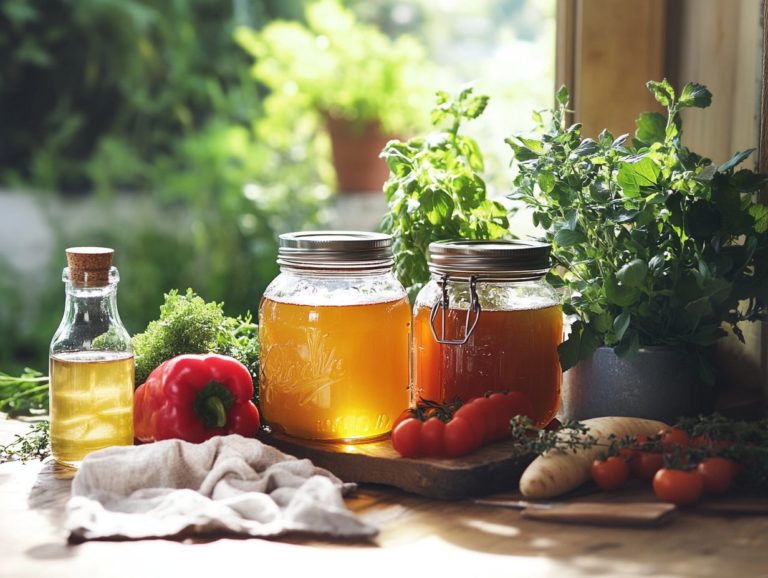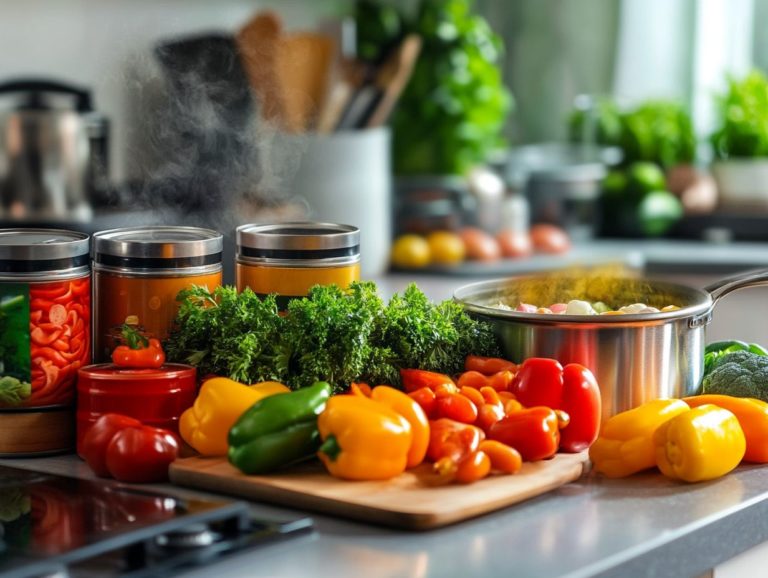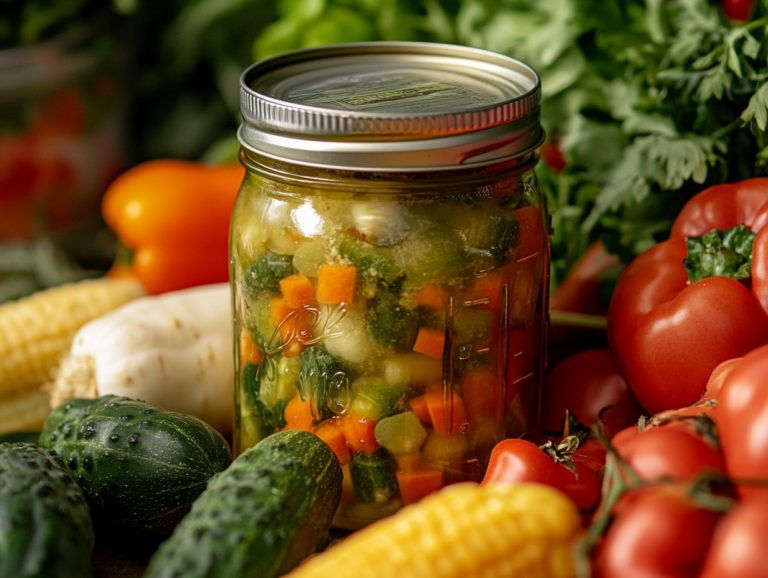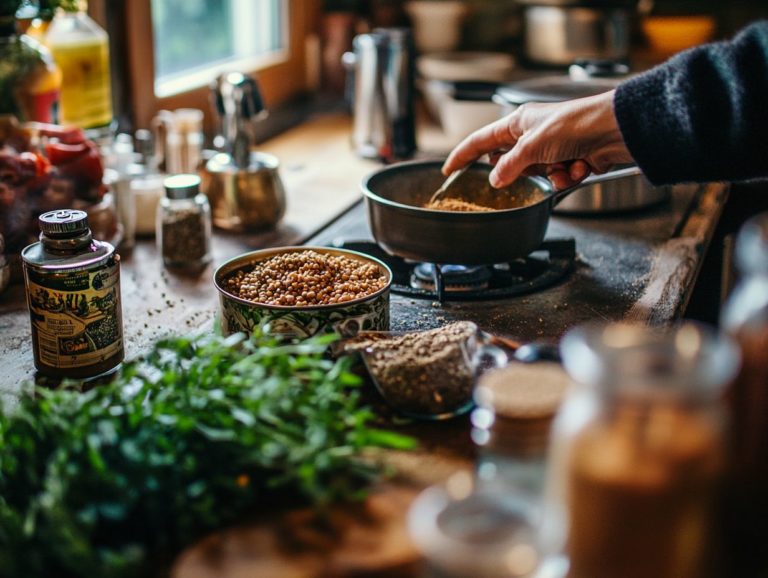Understanding Canning Jar Safety Standards
Canning jars are essential tools for home food preservation, but ensuring their safety is of utmost importance.
This article delves into the world of canning jars and their importance, emphasizing the need to adhere to safety standards to mitigate potential risks.
You will discover the various types of jars available, highlighting their materials and intended uses. We will also explore the key safety standards that you need to keep in mind.
You’ll find practical tips for selecting and maintaining your canning jars, which will guarantee safe and effective preservation.
Let s transform your canning skills today! Let s dive in!
Contents
- Key Takeaways:
- What are Canning Jars?
- Why Canning Jar Safety Standards are Important
- Types of Canning Jars
- Key Safety Standards for Canning Jars
- How to Choose and Maintain Safe Canning Jars
- Frequently Asked Questions
- What are canning jar safety standards?
- Why is it important to understand canning jar safety standards?
- Who sets the canning jar safety standards?
- What are the common safety standards for canning jars?
- Are there different safety standards for different types of canning jars?
- Where can I find more information about canning jar safety standards?
Key Takeaways:

- Always check for canning jar safety standards to ensure safe use.
- Choose jar materials based on the type of food you are preserving.
- Regularly inspect and replace jars for optimal safety.
What are Canning Jars?
Canning jars are specialized containers crafted for home canning, enabling you to preserve food safely and effectively.
These jars typically come in two main materials: glass and BPA-free plastic, each with its own unique advantages. Glass jars are celebrated for their durability and non-reactive properties, making them ideal for both hot water bath canning and pressure canning. Meanwhile, plastic jars offer convenience, often being lighter and easier to handle.
You’ll find each jar available in various sizes, ranging from pint to quart, allowing you to accommodate different quantities of food. Proper labeling and sealing of your jars are crucial to prevent spoilage and maintain freshness.
Sticking to safe canning practices, like using sterilized jars and following recommended recipes, is vital in keeping foodborne illnesses at bay.
Why Canning Jar Safety Standards are Important
Canning jar safety standards are essential for preventing foodborne illnesses and ensuring that your home-canned goods are safe for consumption. By following guidelines established by reputable organizations like the USDA and the Centers for Disease Control, you can effectively minimize concerns about botulism, a serious illness caused by bacteria in improperly canned food.
It’s vital for both novice and seasoned canners to grasp the potential risks of food spoilage and to recognize safe canning practices. Prioritizing these precautions will enhance your canning experience and safeguard the health of you and your loved ones.
Potential Risks of Unsafe Canning Jars
Using unsafe canning jars can expose you to serious health risks, including the potentially lethal effects of foodborne botulism, which arises from neurotoxins produced by Clostridium botulinum. If you don t follow proper canning techniques, you risk poorly sealed jars that allow harmful bacteria to flourish.
It s essential for anyone involved in home canning to recognize the signs of botulism, as this knowledge can be a crucial line of defense against the dangers of consuming contaminated food. Symptoms may include blurred vision, slurred speech, and muscle weakness, often stemming from inadequate heat processing during canning.
If you re engaging in home food preservation, prioritizing safety is non-negotiable. Adhering to established canning guidelines will significantly reduce your risks. These guidelines include:
- Using only reliable jars specifically designed for canning
- Ensuring high-temperature methods are applied correctly
- Checking for tight seals after cooling
By being aware of these practices, you not only safeguard your health but also protect those in your wider community. After all, improper home canning can pose significant dangers to friends and family who enjoy your homemade preserves.
Types of Canning Jars

You ll find a diverse array of canning jars, each crafted to cater to the unique demands of home canning and food preservation. From classic glass jars to specialized varieties designed for pressure canning (a method using high pressure to heat food), and water bath canning (a method using boiling water), your choice of jar can significantly influence both the safety and effectiveness of the canning process.
Understanding these options is essential for anyone aiming to preserve foods successfully. This applies whether you re working with high-acid or low-acid ingredients.
Different Materials and Uses
Canning jars come in various materials glass, plastic, and metal. Each is designed for specific roles in the canning process.
Glass jars are prized for their airtight seal and resistance to leaching. This makes them the go-to choice for preserving high-acid foods like tomatoes and pickles. In contrast, plastic jars are lightweight and shatterproof, but they often fall short in withstanding high heat, making them more suitable for short-term storage rather than long-term preservation.
While metal jars can be used for canning, they are less common due to concerns about rust and reactivity.
When choosing a jar, consider the acidity of your food. Different materials behave differently under various conditions, impacting both flavor stability and safety.
Key Safety Standards for Canning Jars
Knowing safety standards for canning jars is crucial. It helps you succeed in home canning and food preservation. Renowned organizations like the National Center for Home Food Preservation and the USDA provide comprehensive guidelines that establish a solid framework for safe canning methods and procedures.
By adhering to these standards, you significantly reduce the risk of foodborne illnesses. This ensures that your home-canned foods maintain their quality and safety over time.
Factors to Consider for Safe Usage
Several critical factors warrant your attention to ensure effective food preservation and prevent spoilage. The integrity of the jars, the sealing process, and your adherence to safe canning procedures all significantly influence the safety of your home-canned foods. Ignoring these factors could compromise food quality and elevate the risks of foodborne illnesses.
-
First, assess the integrity of your jars. Check for any cracks, chips, or signs of wear that could jeopardize the seal. A thorough inspection ensures that your jars can withstand the pressure and temperatures involved in the canning process.
-
Next, focus on the sealing process. Use new lids specifically designed for canning and follow the recommended heating times. This guarantees an airtight seal that inhibits microbial growth.
-
Finally, adhere to published safe canning procedures, such as those from the USDA or local extension services. These guidelines are essential for preventing contamination and ensuring that your food is preserved safely for future enjoyment.
How to Choose and Maintain Safe Canning Jars
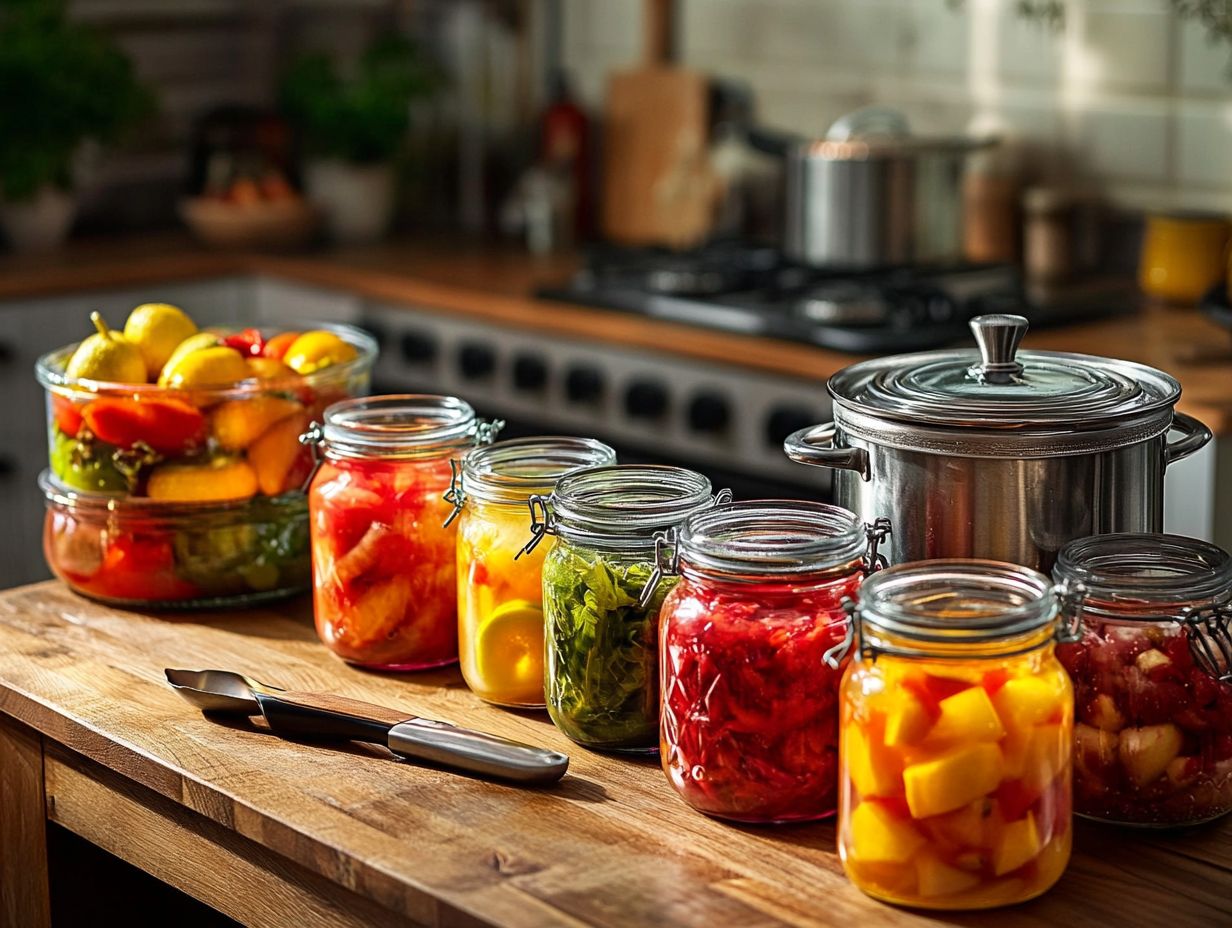
Choosing and maintaining safe canning jars is exciting and essential for your food preservation journey. It’s important to select the right jars based on the type of food you re preserving whether you’re dealing with high-acid or low-acid foods to ensure that your canning methods are effective.
Keeping your jars in pristine condition through regular inspection and cleaning is vital. This practice not only prevents contamination but also enhances the longevity of your carefully home-canned goods.
Tips for Selecting and Caring for Canning Jars
Selecting and caring for canning jars is crucial for effective food preservation. Follow specific guidelines to ensure safety.
Choose jars that are free from cracks and defects. Regularly inspect them for wear and maintain them with proper cleaning techniques.
- Start by opting for jars specifically designed for canning; these are built to withstand high temperatures and create a reliable seal.
- Before you dive in, wash each jar thoroughly with hot, soapy water and give them a close inspection. Any chips or scratches could compromise their integrity.
- After cleaning, rinse and air-dry your jars upside down immediately! This prevents moisture from interfering with the sealing process.
Store your jars in a cool, dark place away from direct sunlight. This helps preserve their quality over time. These simple yet powerful tips boost food safety and extend the life of your jars. Enjoy the rewarding experience of preserving your favorite foods!
Frequently Asked Questions
What are canning jar safety standards?
Canning jar safety standards are guidelines and regulations set by government agencies or organizations to ensure the safe use of canning jars for food preservation.
Why is it important to understand canning jar safety standards?

Understanding canning jar safety standards is important to ensure the safety and quality of preserved foods. Knowing what safety measures to take in canning also helps prevent potential hazards such as food spoilage, contamination, and breakage of jars.
Who sets the canning jar safety standards?
The canning jar safety standards are set by government agencies such as the Food and Drug Administration (FDA) and organizations like the National Center for Home Food Preservation (NCHFP).
What are the common safety standards for canning jars?
Some common safety standards for canning jars include using jars specifically designed for canning, avoiding reusing single-use jars, properly sterilizing jars before use, and following recommended processing times and techniques.
Are there different safety standards for different types of canning jars?
Yes, different types of canning jars may have different safety standards depending on their material and design. For example, mason jars may have different safety guidelines compared to canning jars with screw-on lids.
Where can I find more information about canning jar safety standards?
You can find more information about canning jar safety standards from government websites such as the FDA or the NCHFP. You can also consult with your local extension office or experienced canners for guidance.


